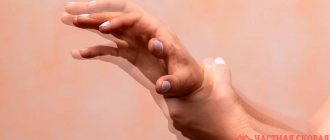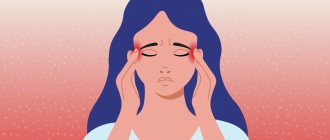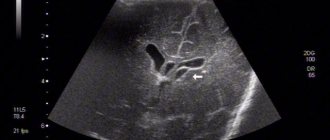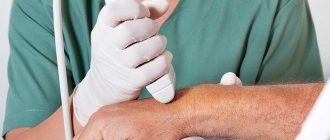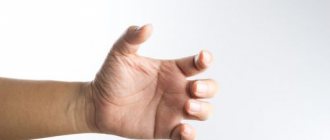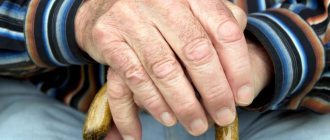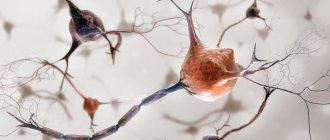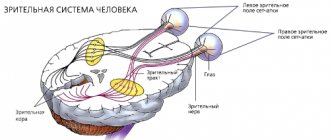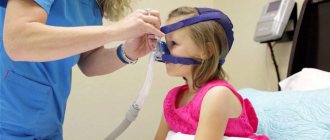Tremor in newborn babies is manifested mainly by twitching of the chin and upper limbs. It can be considered a similar manifestation of muscle hypertonicity, which is the main sign of an immature nervous system of a baby. Tremor in infants manifests itself mainly due to overexcitability of the nervous system when the baby screams, cries, and also when he wants to eat, or someone frightened him. Parents may also notice that their child's eyeballs move during sleep. This usually occurs during a phase of sleep called REM sleep.
Tremor in newborns is not a rare phenomenon; it occurs in almost 50% of all children born. From the first day of life until 4 months, signs of tremor are considered normal, but if they do not disappear after this period, then you need to take a closer look at the baby. It may be worth consulting a doctor at this point. But if the hands and chin have not stopped shaking even after a year, then this is a clear signal about problems with the child’s health. To understand when tremor is a benign specific condition of the nervous system, and when it is a serious problem, we suggest that you read this article.
The children's nervous system lends itself well to “regulation”. Therefore, the sooner you notice the problem and receive qualified help, the greater the chances of normalizing the state of the central nervous system and restoring it.
What is most affected by involuntary shaking in children?
If you look at the statistics, you can make an unambiguous conclusion - often almost all babies have head tremors. This is what indicates the incomplete maturity of the baby’s nervous system. When a baby's arms or legs, as well as lips and chin, shake, this is already a consequence of prematurity.
Parents should also understand that such phenomena do not occur in every child. Therefore, you should not immediately panic while waiting for your baby.
conclusions
Pediatrics operates with the concept of a critical time for a child’s development after birth, especially with regard to the nervous system, disturbances in the functioning of which can cause tremors in newborns.
The 1st, 3rd, 9th and 12th months of a baby’s life are considered critical periods, when nerve endings are highly sensitive and any deviation from the norm can lead to the development of certain pathologies.
To prevent the development of serious problems
which may cause tremors, systematic monitoring of the child’s health is strongly recommended. If you notice signs of tremor in a newborn, there is no need to panic, but you should definitely contact a neurologist.
Tremor in children: main causes
As mentioned above, the culprit may be the immaturity of the nervous system. But other factors, such as premature birth and fetal hypoxia, can also lead to trembling.
The child's immature nervous system
After birth, children do not yet have developed coordination of movements, and their nervous system has not reached the required stage of maturity. This is what most often causes chin tremor in infants, as well as trembling of the limbs. A violent outburst of emotions, which increases the level of norepinephrine in the body, also contributes to the appearance of trembling of the baby’s arms and legs. Increases the chances of developing this phenomenon and muscle hypertonicity.
Fetal hypoxia
Fetal hypoxia, which can develop both in utero and at the time of birth, has become a fairly common problem. Lack of oxygen, especially long-term, negatively affects brain function. A number of factors contribute to the development of hypoxia:
- Disorders of the functional activity of the placenta.
- An infection that developed in utero.
- Increased tone of the uterus when the mother is threatened with miscarriage.
- Bleeding during pregnancy.
- Polyhydramnios.
All these factors limit the supply of oxygen to all cells of the body, including the brain, which also affects the development of the nervous system. In addition, oxygen starvation can be caused by the characteristics of labor (rapid labor and weak contractions), entanglement of the fetus in the umbilical cord, and placental abruption.
Premature birth
Chin tremor in newborns born prematurely also occurs due to the immaturity of the nervous system, since the baby was deprived of continued intrauterine development. Therefore, the central nervous system of a premature baby continues to form outside of the baby’s presence in the womb, and these can hardly be called optimal conditions for this process. No matter how attentively and carefully the mother treats the baby, she is not able to provide him with the atmosphere that was in her stomach. Therefore, we can safely say that limb tremors in children in any case depend on the maturity of the nervous system.
When should you contact a neurologist?
Even the most caring mother, as a rule, does not have a medical education. Therefore, if you have any doubts about your child’s health, you should immediately consult a doctor. The child has difficulty falling asleep, shakes his hand, loses consciousness - these symptoms can be signs of serious illnesses. A neurologist, one of the main doctors in a child’s life, will definitely pay attention to them.
A neurologist is competent to diagnose and treat diseases caused by damage to the nervous system. Among them: various neuralgia, hydrocephalus, epilepsy, etc. Simply put, a neurologist examines the child’s behavior and developed skills, on the basis of which he makes a conclusion about the correct development of the baby. Will the person be socialized, will he be able to find contact with people, and will he be able to speak and think at all. The nervous system is responsible for all this, so it is very important to notice and eliminate any violations in a timely manner.
The formation of a child’s nervous system occurs gradually. With each month of life, the baby acquires new skills: learns to speak, listen, sit, walk, think. Due to the fact that each child develops individually (sometimes, outside the accepted medical framework), developmental deviations can only be noticed at a repeat appointment with a neurologist. The Russian Ministry of Health has defined 4 age stages: 1, 3, 6 and 12 months. But even if there are several weeks left until the next examination, and the child has dangerous symptoms (increased muscle tone, tremors, frequent regurgitation, constant hysterics), there is no need to delay, you should urgently see a doctor.
So, what symptoms should alert parents and become a reason for an unscheduled visit to a doctor?
1.
The child's chin is trembling.
Trembling of the chin when crying in a child under three months is considered normal. This happens because the nervous system is not yet fully formed. Under the influence of simple emotions, the nerve centers are excited, and a slight tremor appears. It’s another matter if the child’s chin trembles at rest, and this symptom did not appear immediately, but several months after birth. Please note: in parallel with chin trembling, there may be other symptoms (frequent regurgitation, increased muscle tone, trembling of the entire head). This is a common phenomenon, especially if there was a difficult birth, hypoxia, or the child was born premature. And yet, if you notice that your baby’s chin trembles often and for a long time, you should talk about it at an appointment with a neurologist.
2.
The child developed tremors (arms, legs).
Trembling hands or feet is a symptom of increased excitability; it also appears due to the immaturity of the nervous system. The appearance of this sign without the child’s physical or emotional activity indicates possible serious disorders. Tremor in a child appears in very serious diseases, such as encephalopathy, hyperglycemia, etc. Only a competent neurologist at an appointment can study the child’s condition, rule out pathology or prevent it from developing.
Increased muscle tone.
For newborn children, a condition in which muscle tone is decreased or increased is absolutely normal; it occurs in more than half of babies. Typically, after a few weeks, the muscular dystonia goes away and the baby begins to fully develop. However, if muscle tone remains elevated or decreased after six months, you need to sound the alarm. Muscular dystonia, if not treated, will lead to delays in physical and mental development. For example, due to increased muscle tone in the future, a child may develop hyperexcitability, and due to decreased muscle tone, posture may become distorted and even speech may be impaired.
Decreased muscle tone.
The picture is similar with decreased tone, but, unlike increased tone (when a child can beat himself with his hands or has torticollis), here, on the contrary, the baby is lethargic, motionless, and often lies in a frog position. This condition will also negatively affect the child's health. As a rule, such children develop more slowly than their peers, begin to crawl and sit up later, and have little interest in the world around them. In addition, this symptom (along with frequent crossing of the legs) may occur with cerebral palsy. Even if the doctor has not diagnosed this serious disease, increased or decreased muscle tone must be treated. Moreover, it can be easily corrected (massage, physiotherapy).
The baby spits up frequently
The first and main reason for frequent regurgitation in children is overeating. Unlike vomiting, this process occurs easily, without gushing, within a short period of time after feeding, in a volume of about 1-2 tablespoons. Usually, regurgitation does not affect the baby’s health in any way; his fragile body simply gets rid of excess food. You need to build the correct feeding scheme according to age and this symptom will go away. But if regurgitation continues for a long time, occurs in large volumes, the baby does not gain weight, and behaves passively, this is a reason to turn to specialists. Frequent regurgitation can be a symptom of bloating, various gastrointestinal defects, in children with intrauterine growth retardation.
The child loses consciousness
In such cases, you can’t hesitate, you need to immediately call an ambulance! At this time, try to help the baby, note how quickly he came to his senses, whether his breathing was impaired, or whether his skin color changed. Loss of consciousness is a very alarming symptom; it can accompany both completely harmless overheating, dehydration, lack of oxygen, and extremely serious diseases: diabetes, epilepsy, asthma, vegetative-vascular dystonia, etc. In the case when a child often loses consciousness, You will need to consult not only a neurologist, but also other specialists.
The child has dilated pupils
There can be a lot of reasons for this condition, ranging from poor lighting in the room where the child spends most of his time to serious pathologies. At an appointment with a neurologist, you need to explain how long ago the pupils dilated, whether this condition is changing and what caused it. It is believed that a child may have dilated pupils after suffering a severe fright or witnessing a conflict. A nervous breakdown, stress, severe or frequent headaches cause dilated pupils. Also, dilated pupils in a child are one of the signs of traumatic brain injury. In addition, it is necessary to exclude eye diseases and hypoxia, so a professional examination cannot be avoided.
Frequent tantrums in a child
This condition should not be attributed to the complex nature of the child. Of course, the psychological aspect takes place, especially in 3-year-old children, when the first age crisis occurs. They are not yet able to clearly formulate their desires, so they achieve their goal with the help of hysterics, screaming, and beating with their hands. In this case, the advice of a psychologist will help. Meanwhile, the cause of constant hysterics in a child (especially under the age of one year) can be painful sensations against the background of neurological abnormalities. Increased intracranial pressure and hydrocephalus have in their symptoms: tantrums in children, tremors, poor sleep. Don’t think that everything will go away on its own when the child grows up. Serious pathologies can lead to serious consequences, including disability.
Poor sleep in a child
Children often have difficulty falling asleep due to overexcitation (strong emotions, new surroundings, many people around, quarrels in the family). It is important not to put the child to bed in this state, but to achieve complete calmness with the help of a relaxing bath, warm drinks and close contact with the mother in a cozy environment. Otherwise, due to overexcitation, there will be interrupted sleep, and the child will get even more tired. Be sure to follow a routine, including daytime sleep, so it will be easier for the baby’s nervous system to cope with overload. But if the child does not fall asleep well, sleep is short, the baby twitches in his sleep, and when he wakes up he cries, you should look for a good neurologist. At an appointment at the Center for Pediatrics and Neurology, a neurologist will examine the child using amplitude-frequency diagnostics and identify the reason why the child has trouble falling asleep.
So, your child’s future now depends on how carefully you pay attention to his health and early development. It is worth adding that any treatment must be carried out under the supervision of a competent doctor. It is better if the baby is observed by a permanent doctor in a specialized center. At the Research Institute of Neurology and Pediatrics “Indigo Children”, neurologists and other children’s specialists receive appointments: pediatricians, speech therapists, defectologists, exercise therapy instructors, massage therapists, psychologists, etc.
Targeted treatment and its necessity
Based on the data available to doctors, we can say that the concern is caused by tremor that persists for 4 months. In this case, the shaking spreads to the baby’s legs and head, and the mother knows for sure that the baby is not shaking at certain moments (hunger, fear, etc.). Parents should understand that such a phenomenon may be a warning sign of the following problems:
- Hypomagnesemia.
- Increased blood sugar levels.
- Intracranial hemorrhage.
- Drug withdrawal or withdrawal syndrome.
- Hypoxia-ischemia of the brain.
- Increased intracranial pressure.
- Low calcium levels in the blood.
- Sepsis.
In these cases, the doctor will definitely prescribe you a full examination and appropriate treatment.
Clinical picture of the disease
Tremor in newborns has a specific course and has characteristic manifestations:
- As a rule, with tremors in newborns, the lower lip and chin most often tremble. Less commonly, twitching of the lower or upper extremities is observed.
- Trembling can be asymmetrical - in this case, parts of the body tremble separately. For example, the chin and arms, one leg and one arm can tremble at the same time.
- If the tremor is symmetrical and not too intense, this is also considered a normal variant. The movements in both situations are small and rhythmic.
- Physiological tremor should last literally a few seconds. Twitching is usually observed during periods of crying or severe nervous tension, for example, after bathing. However, in some cases they may appear suddenly.
- Tremors may first appear or get slightly worse after the first month of life.
Before this, there is a period of adaptation when it is recommended to protect the child from external stimuli. After a month, the baby can already take water and air baths, and therefore the load on the nervous system increases significantly.
Most often, tremor in a newborn baby is a cause for parental concern. However, up to three months, this condition is considered absolutely physiological, and it is caused only by the immaturity of the nervous system.
Parents should be wary if after three months the symptoms of tremor do not decrease, but rather increase. In addition, concerns should be raised by the fact that twitching occurs for no obvious reason, and the child is characterized by increased excitability - for example, he reacts too violently to sudden movements or sounds.
In this case, you should definitely contact a neurologist.
This condition may be associated with diseases such as:
- Hypoxic-ischemic encephalopathy.
- Sepsis.
- Intracranial hemorrhage.
- Hypocalcemia.
- Hypomagnesemia.
- Hyperglycemia.
- Increased intracranial pressure.
- Drug withdrawal syndrome.
What is the treatment
If a child’s arms, legs or head are shaking, then treatment should be aimed not only at restoring the state of the nervous system, but also at health in general. That is why the mother must strictly follow the neurologist’s instructions and adhere to all recommendations. Most often, medications such as Glycine, Asparkam, etc. are prescribed. But only a pediatric neurologist can identify the exact cause of trembling limbs and prescribe medications. Therefore, self-medication is dangerous.
But the procedures that are necessarily prescribed for children suffering from tremors are simply necessary. First of all, this is massage, gymnastics and swimming.
At what age does the appearance of tremor become a sign of illness?
In the development of a baby in the first year of life, these are the so-called critical periods of the formation of the nervous system. At this time, it is most vulnerable to disruptions in its functioning. These periods include the first and third, as well as the ninth and twelfth months of the baby’s life.
By the way, it is at this time that you should visit a pediatric neurologist. If tremors of the limbs or chin are observed longer than the specified age, then this can act as a sign of damage to the nervous system both during pregnancy and childbirth.
Massage treatments for tremors
At home, giving a baby a massage is quite simple, and any mother can handle it. The main thing is to combine massage with constant conversations with the baby. The main movements of massage include kneading, stroking, rubbing and vibration. Usually the doctor himself gives an example of how you should do a massage. But you can also watch a special video below.
In the meantime, I would like to say that during the session your baby should feel as comfortable as possible, because all your actions are aimed specifically at strengthening the child’s nervous system. Therefore, it is worth remembering some rules:
- Ventilate the room well.
- Before the massage, be sure to remove your rings and bracelets so as not to scratch your baby. It is also a good idea to cut your nails.
- Rub your palms together and knead your hands.
- Massage should be done only when the child is active and in a good mood.
- If during the process the child’s mood worsens, then stop the session. The baby should calm down and become cheerful again.
- Do not bring your baby to the clinic for a massage. It’s better to hire a massage therapist and introduce him to the child so that he can get used to a stranger. Ideally, it is better to do the massage yourself in an atmosphere familiar to the baby.
- Nothing should irritate the child. It is better to eliminate loud music, bright lights and other external factors before the massage session.
- Be sociable and affectionate with your child. Songs, rhymes and funny jokes are the best accompaniments to any procedure.
- Do a massage half an hour before water treatments. This way you can provide your baby with even more “relaxation”.
What does massage treat?
Manipulation is truly an indispensable procedure in the treatment of young children. Due to the minimal number of contraindications, it is widely prescribed not only for pathologies of the musculoskeletal system or nervous system. The procedure helps to cope with the consequences of injuries and speed up recovery from respiratory diseases.
When is massage prescribed for a newborn:
- Cerebral palsy.
- Torticollis and chest deformities.
- Congenital hip dislocation or dysplasia.
- Damage to the shoulder joint.
- Gastrointestinal diseases, including colic.
- Deformities of the legs and feet (varus, valgus, clubfoot).
- Metabolic disorders, especially during the period of rehabilitation of the consequences of rickets.
- Muscle wasting.
- Bronchial asthma.
The procedure is an important part of complex therapy, accelerating the healing process. Usually prescribed in conjunction with physical therapy and gymnastics. Treatment can be supplemented with reflexology.
The limitation for massage is high temperature and acute infectious or inflammatory process. Contraindications are also the presence of skin diseases, severe circulatory disorders and oncological processes.
Swimming and gymnastics
If you have not yet decided to send your baby to infant swimming, then you can carry out water procedures at home. If a child has tremors of the limbs, then it will be extremely useful for him to swim, even while in your arms. Let the baby have plenty of play with his hands and feet, and let the water in the bathroom be at the most comfortable temperature.
Gymnastics for a baby is also useful. There are a number of exercises that you can also do with your baby at home.
- Grab your baby's foot with one hand and tap the outside of his leg with the other. This exercise is called the “hammer” and is repeated on both legs alternately.
- Stroke your baby's arms and legs. Take the baby by the hand and, shaking it slightly, lower yourself from the shoulder to the wrist. This exercise should be performed on the legs and arms alternately.
- Stretch your baby's buttocks. To do this, place the baby on his tummy and just lightly tap his butt with your little fists.
Remember that tremors are a completely natural phenomenon and should not cause you to panic. But you must monitor your baby daily. Children under one year old continue to develop, so you need to not miss the moment when you, together with a specialist, can make any adjustments. Doctors note several critical periods in a baby’s life. These are 1, 3, 9 and 12 months. It is at this time that the nerve endings become very sensitive, and any deviation can cause pathologies. Therefore, the future health of your baby depends on your attention and participation.
Treatment methods
Tremor in newborns is considered a completely normal phenomenon, which occurs in every second child. Dr. Komarovsky claims that the nervous system of a newborn baby has a number of distinctive features.
At the same time, the baby’s muscle tone is more clearly expressed in the muscles that bend his arms and legs. This is why tremor is considered completely normal and does not require treatment.
If twitching occurs exclusively during fright, crying and during REM sleep, then parents should not worry. If there are no apparent reasons for this condition, the doctor should examine the child.
In most cases, such children are prescribed swimming, gymnastics and therapeutic massage. How to treat tremor in newborns and whether it needs to be treated can only be decided by a specialist.
Most often, regular relaxing massage is indicated in this case. Warm baths with the addition of lemon balm, mint, and valerian can also be prescribed. These herbs have a calming effect, which has a positive effect on the baby’s health.
In order not to cause an allergic reaction, you should not do such baths too often - three times a week will be enough.
Everyone has had a headache in their temples.
From the article you will learn how to deal with it. About the main symptoms of occipital neuralgia here.And you can find out what neuralgia of the facial nerve looks like in the photo by following the link https://gidmed.com/bolezni-nevrologii/nevralgija/nevralgiya-litsevogo-nerva.html.
Massage technique
It is recommended to start massage for a newborn baby after he is 5-6 weeks old.
All movements used should be performed along the joints, namely from the periphery towards the center.
The massage must be done on a hard surface, and the room must be ventilated and ensure that it is warm enough.
For the procedure to be effective, it is enough to master a few simple movements, these include:
- stroking;
- kneading;
- vibration;
- trituration.
While stroking the baby, movements should be made along the lymph flow in the direction of nearby lymph nodes. The legs should be stroked from the feet to the groin. Hands should be stroked, starting from the hands towards the armpits.
If you stroke the belly, it is not recommended to touch the liver area. While stroking the back, do not touch the spinal column.
With the help of stroking, it is possible to improve blood supply to internal organs and tissues. This procedure also allows you to relax muscles, relieve pain, and calm the baby.
Rubbing is very beneficial for a child under one year old.
To do this, you need to perform straight and spiral movements with your fingertips. Such procedures have a positive effect on the skin, muscles, ligaments and tendons.
Kneading makes it possible to activate blood circulation and calm the nervous system. It needs to be done gently and at the same time quite energetically.
There are several types of movements that are very useful for children up to one year old and after:
- "Hang glider."
To perform this massage, you need to stroke the baby from the sacrum towards the armpits. With this procedure, it is possible to calm the child and increase the flow of lymph. - "Hot track"
Use the edges of your palms to rub the strip located along the spine. After this procedure, the child’s skin should turn pink. - "Geese."
This massage is performed by pinching the skin on the back.
Moreover, it is recommended to pay special attention to the shoulder blades, shoulders and the area along the spine. movement will be performed in a similar way .
However, in this case the child needs to be tapped. - "Spiral".
When performing spiral movements, it is necessary to move from the sacrum towards the baby’s neck, and this should be done along the spine. During this procedure, it is very important to feel all the vertebrae. - "Wave".
This procedure can be started when the baby's skin is well warmed up. Only in this case your movements will not cause pain in the child. It is necessary to grab a fold of skin with your fingers and begin to quickly finger it. You should move along the spine, from the sacrum to the shoulders and armpits.
In the video you can see techniques for performing massage and gymnastics that will be useful for a newborn with tremors:
Basic recommendations
Despite the wide possibilities of massage, before the course you should familiarize yourself with the basic rules:
- Perform half an hour after meals or 40 minutes before feeding.
- The baby's skin should be dry and clean.
- It is not advisable to carry out the procedure right before bedtime.
- The child should be calm, not cry or scream.
Simple movements can be performed at home yourself. The main thing is to monitor the baby’s comfort, avoiding tension or anxiety. Stroking is performed from top to bottom, in the direction of blood flow. Your local pediatrician can teach you the correct actions. It is better to entrust therapeutic and restorative massage to professionals.
Important: until 3 months of age, the armpits, fontanel and inner thigh areas are not massaged.
Massage for babies is not necessarily prescribed by a doctor. You can sign up for a health course without special indications; the procedure is especially important for premature babies and children born by cesarean section.
Signs and manifestations
Trembling in the lower part of the face in a baby occurs most often during feeding or bathing, while crying, and sometimes during sleep. The movements are repeated quickly, the amplitude is small. May be accompanied by twitching of the limbs. It appears regularly, although there are no stressful situations, the child is simply overexcited, and the muscles are in high tone. Even feeding can be a factor that causes overstimulation. For children older than 3 months, it may be a sign of neurological immaturity.
Opening hours: 8:00 to 20:00
Telephone
Sign up
